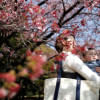Every country in the world has their own cuisine and their etiquettes defined by their culture. Japan is no different. With their delectable cuisine on the table, it's hard to focus on something else. Nevertheless, one must not forget about the dining etiquettes.
Sitting arrangements are important
While tables and chairs are certainly found in restaurants, in the more traditional ones and most likely at someone's house, the sitting arrangement will be on a traditional tatami floor. When this is the case, one should always remove their shoes. In addition, in a formal or special meal, the sitting arrangements are symbolic. The middle seat is the most honourable position and usually for the host with the guest sitting opposite to him on the other side of the table.
Mind the chopsticks
For many people, using chopsticks itself is a challenge. But it must be kept in mind that in addition to their proper use, there are a number of etiquettes regarding chopsticks. For example, one should never rest their chopsticks on the bowl. Always rest your chopsticks on the chopsticks rest or if that's not available then one may use the wrapper.
Never point the chopsticks to another person or wave it all over the table since it is considered very rude. Similarly, stabbing the food with chopsticks or rubbing them together unnecessarily isn't a good idea either. If you are struggling to use the chopsticks, it is okay to ask for a fork.
Be considerate about soy sauce
Soy sauce has been part of Japanese cuisine and history for hundreds of years and real authentic soy sauce are regarded very highly in Japan. In any meal, soy sauce is provided in a small bowl. Do not pour soy sauce directly over rice. Avoid pouring too much soy sauce, only take as much as you need. If you need more soy sauce, you can always pour more but taking too much soy sauce and wasting it is culturally frowned upon and therefore should be avoided. Also, do not mix wasabi with soy sauce since it is considered disrespectful.
Starting and finishing the meal
Before starting a meal, Hand towels or "oshibori" will be offered. It must be used to wipe your hands only and not your face. It is polite to wait for everyone's meal to arrive at the table and then start together. Before starting to eat, it is customary to say "Itadakimasu," which means "I gratefully receive." It's a way of saying thanks to everyone involved in preparing the meal as well as acknowledging the meals served on the table.
It is polite to eat everything right down to the last grain and not waste any food. Slurping is okay in Japanese culture. In fact, it indicates that the meal was delicious. At the end of the meal, it is good manners to return the dishes to their original position and saying thank you for the meal.
Drinking etiquettes
Just like food, do not start drinking till everyone has their drinks in their hands. Alcoholic or not, the custom is to start drinking after a toast by saying 'Kanpai.' It is considered rude to pour one's own drink. Instead, pour for each other. Since one is not supposed to pour for oneself, it is wise to keep an eye out to see if anyone's glass is empty and offer to pour for them.
If you are not offered before your glass becomes empty, you may ask for a refill.
Japan is culturally rich and has a number of interesting etiquettes. If you are visiting Japan or just simply trying their cuisine, you should show proper respect to their culture, values and follow the etiquettes. It's just good manners and Japanese are well known for their manners all over the world.








Comments